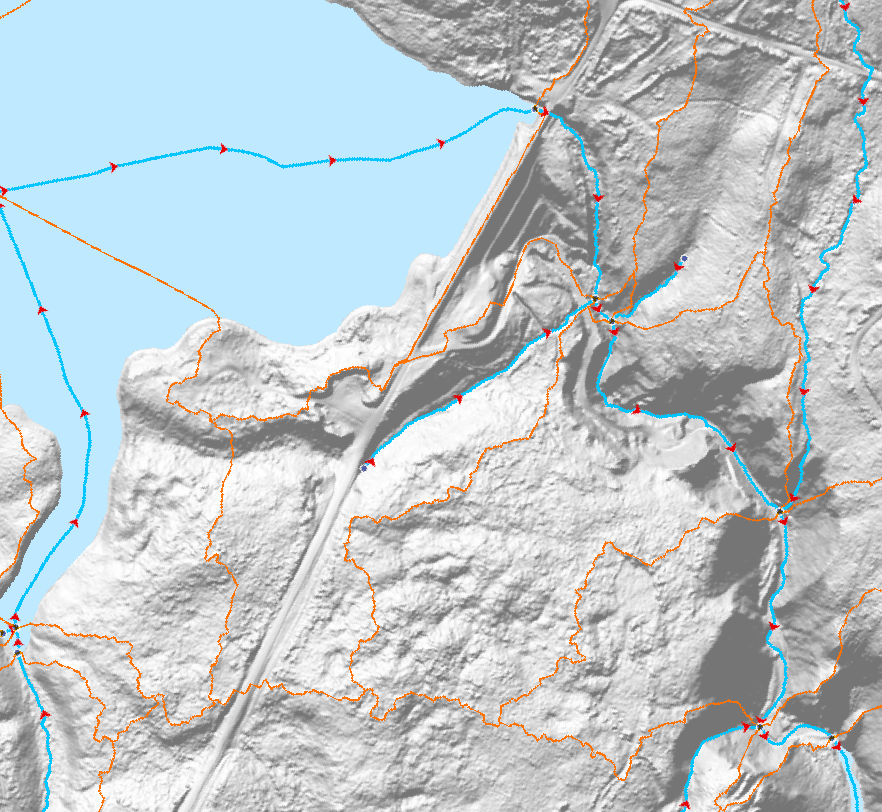Watercourses
Type of resources
Available actions
Topics
Keywords
Contact for the resource
Provided by
Formats
Representation types
Update frequencies
status
Scale
-
Provinces and Territories Basemap - Canada Provinces basemap file created to generate boundary polygons for use in small scale, medium and large scales. Simple Grey Basemap - This basemap is only in simple grey and white to be used as a backdrop in applications or geomatics projects. Line features represent provincial and territorial boundaries, international boundaries, exclusive economic zones, arcs extending to the North Pole, state boundaries, Canadian, USA and foreign countries rivers. Polygon features representing waterbodies in Canada, USA and foreign countries.
-

The Canadian Hydrospatial Network (CHN) is an analysis-ready geospatial network of features that help enable the modelling of surface water flow in Canada. The six main layers and feature types are: flowlines, waterbodies, catchments, catchment aggregates, work units, and hydro nodes. Where possible the CHN is derived from high resolution source data such as Light Detection and Ranging (LiDAR) derived Digital Elevation Models (DEMs) and aerial imagery, to name a few. If existing provincial or territorial hydrographic networks meet the standards, they are incorporated into the CHN, otherwise automatic extraction methods are used on the high-resolution source data. To provide full network connectivity, if neither of these methods is possible in a region, the NHN is converted into the CHN until higher-resolution source data is available. Additional value-added attributes are included in the CHN to aid modelling, such as stream order and reach slope. The CHN physical model and features are also closely aligned and harmonized with the USGS 3DHP hydrographic network, which aids trans-border modelling. Where possible geonames (i.e. toponyms) are also added. The CHN is produced and disseminated by hydrologically connected geographic areas called work units. Work units can contain just one watershed, several small adjacent watersheds outletting into a large body of water, or be one of many parts of a larger watershed. In all cases, the features of a work unit are hydrologically connected. This is a more natural approach to data delivery, in comparison to data that is split into tiles. A generalized work unit index file is provided in the downloads to help users decide which files to download. For more information on the CHN please visit the project webpage: https://natural-resources.canada.ca/canadian-hydrospatial-network
-

The hydrographic features of the CanVec series include watercourses, water linear flow segments, hydrographic obstacles (falls, rapids, etc.), waterbodies (lakes, watercourses, etc.), permanent snow and ice features, water wells and springs. The Hydrographic features theme provides quality vector geospatial data (current, accurate, and consistent) of Canadian hydrographic phenomena. It aims to offer a geometric description and a set of basic attributes on hydrographic features that comply with international geomatics standards, seamlessly across Canada. The CanVec multiscale series is available as prepackaged downloadable files and by user-defined extent via a Geospatial data extraction tool. Related Products: [Topographic Data of Canada - CanVec Series](https://open.canada.ca/data/en/dataset/8ba2aa2a-7bb9-4448-b4d7-f164409fe056)
-
The National Hydro Network (NHN) focuses on providing a quality geometric description and a set of basic attributes describing Canada's inland surface waters. It provides geospatial digital data compliant with the NHN Standard such as lakes, reservoirs, watercourses (rivers and streams), canals, islands, drainage linear network, toponyms or geographical names, constructions and obstacles related to surface waters, etc. The best available federal and provincial data are used for its production, which is done jointly by the federal and interested provincial and territorial partners. The NHN is created from existing data at the 1:50 000 scale or better. The NHN data have a great potential for analysis, cartographic representation and display and will serve as base data in many applications. The NHN Work Unit Limits were created based on Water Survey of Canada Sub-Sub-Drainage Area.
-

This collection is a legacy product that is no longer supported. It may not meet current government standards. The North American Atlas data are standardized geospatial data sets at 1:10,000,000 scale. A variety of basic data layers (e.g. roads, railroads, populated places, political boundaries, hydrography, bathymetry, sea ice and glaciers) have been integrated so that their relative positions are correct. This collection of data sets forms a base with which other North American thematic data may be integrated. The North American Atlas data are intended for geographic display and analysis at the national and continental level. Any data outside of Canada, Mexico, and the United States of America included in the North American Atlas data sets is strictly to complete the context of the data.
 Arctic SDI catalogue
Arctic SDI catalogue